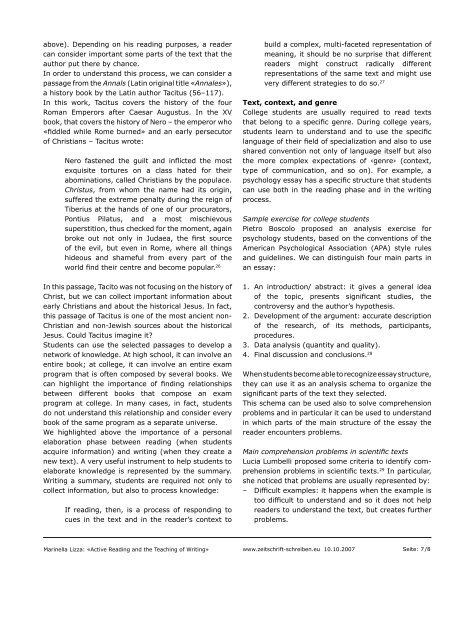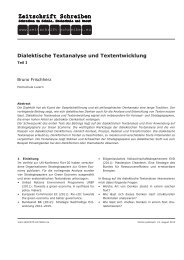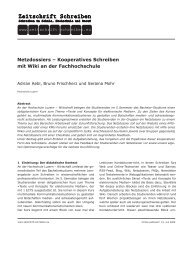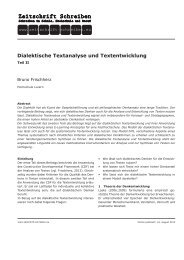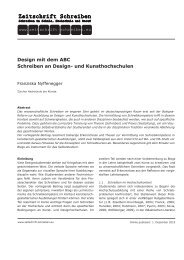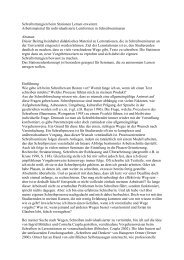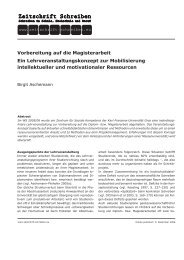Active Reading and the Teaching of Writing - Zeitschrift Schreiben
Active Reading and the Teaching of Writing - Zeitschrift Schreiben
Active Reading and the Teaching of Writing - Zeitschrift Schreiben
You also want an ePaper? Increase the reach of your titles
YUMPU automatically turns print PDFs into web optimized ePapers that Google loves.
above). Depending on his reading purposes, a reader<br />
can consider important some parts <strong>of</strong> <strong>the</strong> text that <strong>the</strong><br />
author put <strong>the</strong>re by chance.<br />
In order to underst<strong>and</strong> this process, we can consider a<br />
passage from <strong>the</strong> Annals (Latin original title «Annales»),<br />
a history book by <strong>the</strong> Latin author Tacitus (56–117).<br />
In this work, Tacitus covers <strong>the</strong> history <strong>of</strong> <strong>the</strong> four<br />
Roman Emperors after Caesar Augustus. In <strong>the</strong> XV<br />
book, that covers <strong>the</strong> history <strong>of</strong> Nero – <strong>the</strong> emperor who<br />
«fiddled while Rome burned» <strong>and</strong> an early persecutor<br />
<strong>of</strong> Christians – Tacitus wrote:<br />
Nero fastened <strong>the</strong> guilt <strong>and</strong> inflicted <strong>the</strong> most<br />
exquisite tortures on a class hated for <strong>the</strong>ir<br />
abominations, called Christians by <strong>the</strong> populace.<br />
Christus, from whom <strong>the</strong> name had its origin,<br />
suffered <strong>the</strong> extreme penalty during <strong>the</strong> reign <strong>of</strong><br />
Tiberius at <strong>the</strong> h<strong>and</strong>s <strong>of</strong> one <strong>of</strong> our procurators,<br />
Pontius Pilatus, <strong>and</strong> a most mischievous<br />
superstition, thus checked for <strong>the</strong> moment, again<br />
broke out not only in Judaea, <strong>the</strong> first source<br />
<strong>of</strong> <strong>the</strong> evil, but even in Rome, where all things<br />
hideous <strong>and</strong> shameful from every part <strong>of</strong> <strong>the</strong><br />
world find <strong>the</strong>ir centre <strong>and</strong> become popular. 26<br />
In this passage, Tacito was not focusing on <strong>the</strong> history <strong>of</strong><br />
Christ, but we can collect important information about<br />
early Christians <strong>and</strong> about <strong>the</strong> historical Jesus. In fact,<br />
this passage <strong>of</strong> Tacitus is one <strong>of</strong> <strong>the</strong> most ancient non-<br />
Christian <strong>and</strong> non-Jewish sources about <strong>the</strong> historical<br />
Jesus. Could Tacitus imagine it?<br />
Students can use <strong>the</strong> selected passages to develop a<br />
network <strong>of</strong> knowledge. At high school, it can involve an<br />
entire book; at college, it can involve an entire exam<br />
program that is <strong>of</strong>ten composed by several books. We<br />
can highlight <strong>the</strong> importance <strong>of</strong> finding relationships<br />
between different books that compose an exam<br />
program at college. In many cases, in fact, students<br />
do not underst<strong>and</strong> this relationship <strong>and</strong> consider every<br />
book <strong>of</strong> <strong>the</strong> same program as a separate universe.<br />
We highlighted above <strong>the</strong> importance <strong>of</strong> a personal<br />
elaboration phase between reading (when students<br />
acquire information) <strong>and</strong> writing (when <strong>the</strong>y create a<br />
new text). A very useful instrument to help students to<br />
elaborate knowledge is represented by <strong>the</strong> summary.<br />
<strong>Writing</strong> a summary, students are required not only to<br />
collect information, but also to process knowledge:<br />
If reading, <strong>the</strong>n, is a process <strong>of</strong> responding to<br />
cues in <strong>the</strong> text <strong>and</strong> in <strong>the</strong> reader’s context to<br />
build a complex, multi-faceted representation <strong>of</strong><br />
meaning, it should be no surprise that different<br />
readers might construct radically different<br />
representations <strong>of</strong> <strong>the</strong> same text <strong>and</strong> might use<br />
very different strategies to do so. 27<br />
Text, context, <strong>and</strong> genre<br />
College students are usually required to read texts<br />
that belong to a specific genre. During college years,<br />
students learn to underst<strong>and</strong> <strong>and</strong> to use <strong>the</strong> specific<br />
language <strong>of</strong> <strong>the</strong>ir field <strong>of</strong> specialization <strong>and</strong> also to use<br />
shared convention not only <strong>of</strong> language itself but also<br />
<strong>the</strong> more complex expectations <strong>of</strong> ‹genre› (context,<br />
type <strong>of</strong> communication, <strong>and</strong> so on). For example, a<br />
psychology essay has a specific structure that students<br />
can use both in <strong>the</strong> reading phase <strong>and</strong> in <strong>the</strong> writing<br />
process.<br />
Sample exercise for college students<br />
Pietro Boscolo proposed an analysis exercise for<br />
psychology students, based on <strong>the</strong> conventions <strong>of</strong> <strong>the</strong><br />
American Psychological Association (APA) style rules<br />
<strong>and</strong> guidelines. We can distinguish four main parts in<br />
an essay:<br />
1. An introduction/ abstract: it gives a general idea<br />
<strong>of</strong> <strong>the</strong> topic, presents significant studies, <strong>the</strong><br />
controversy <strong>and</strong> <strong>the</strong> author’s hypo<strong>the</strong>sis.<br />
2. Development <strong>of</strong> <strong>the</strong> argument: accurate description<br />
<strong>of</strong> <strong>the</strong> research, <strong>of</strong> its methods, participants,<br />
procedures.<br />
3. Data analysis (quantity <strong>and</strong> quality).<br />
4. Final discussion <strong>and</strong> conclusions. 28<br />
When students become able to recognize essay structure,<br />
<strong>the</strong>y can use it as an analysis schema to organize <strong>the</strong><br />
significant parts <strong>of</strong> <strong>the</strong> text <strong>the</strong>y selected.<br />
This schema can be used also to solve comprehension<br />
problems <strong>and</strong> in particular it can be used to underst<strong>and</strong><br />
in which parts <strong>of</strong> <strong>the</strong> main structure <strong>of</strong> <strong>the</strong> essay <strong>the</strong><br />
reader encounters problems.<br />
Main comprehension problems in scientific texts<br />
Lucia Lumbelli proposed some criteria to identify comprehension<br />
problems in scientific texts. 29 In particular,<br />
she noticed that problems are usually represented by:<br />
– Difficult examples: it happens when <strong>the</strong> example is<br />
too difficult to underst<strong>and</strong> <strong>and</strong> so it does not help<br />
readers to underst<strong>and</strong> <strong>the</strong> text, but creates fur<strong>the</strong>r<br />
problems.<br />
Marinella Lizza: «<strong>Active</strong> <strong>Reading</strong> <strong>and</strong> <strong>the</strong> <strong>Teaching</strong> <strong>of</strong> <strong>Writing</strong>» www.zeitschrift-schreiben.eu 10.10.2007 Seite: /8


